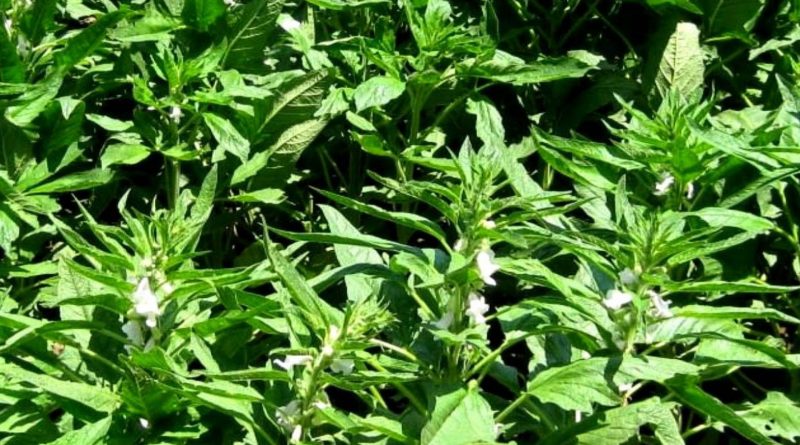Sesamum indicum
Sesamum indicum
Sesame (Sesamum indicum L.) is an herbaceous species belonging to the Pedaliaceae family with origins in India and Africa; of this plant seeds are used in human nutrition.
Systematics –
Sesame, from the systematic point of view, belongs to the Eukaryota Domain, Kingdom Plantae, Magnoliophyta Division, Magnoliopsida Class, Order Scrophulariales, Family Pedaliaceae and then to the Genus Sesamum and to the Specie S. indicum.
Etymology –
The epithet of the genus comes from Sesamum and then from the Arab sémsem, in assonance with the Hebrew sémen: oil. The specific term indicum, comes instead from India or India for the alleged area of origin.
Geographic Distribution and Habitat –
The original distribution of Sesamum indicum is in fact between East African and Indies, so much so that it is cultivated in the Middle East from the beginning of history. Sesame cultivation is believed to be the oldest man-made oilseed crop. Although the area of origin of the plant is uncertain many wild species are common in Africa and some others in India.
Description –
The Sesamum indicum is an annual plant with a size between 50 and 100 cm in height; has very long lanceolate leaves. Sesame flowers are white and tubular long from 3 to 5 cm. The seeds of this plant are small, white or black, depending on the variety. There are varieties of white sesame and others of black sesame.
Cultivation –
The cultivation of the Sesamum indicum is among the most ancient practices; the cultivation of sesame is still carried out today to extract the oil from its seeds, a highly stable precious oil that does not become rancid in the presence of cold or humidity. It is cultivated mainly in the Middle East for thousands of years as evidenced by the discovery of many ancient presses that were used to grind small seeds and extract the oil. As for the cultivation technique it is simple and it is also possible in our latitudes, especially in southern Italy. It is a rustic plant that adapts to difficult conditions such as drought, heat and wind typical of the arid and sunny regions from which it comes.
Uses and Traditions –
The Sesamum indicum is famous in Middle Eastern literature and has become famous the phrase “open sesame!” In the story “Ali Baba and the 40 thieves” from the book “The Thousand and One Nights”. The small seeds of sesame are used, like thousands of years ago, to garnish scones, sandwiches, breadsticks and to flavor sweet bars made more tasty by sesame seeds. In the Middle East there are numerous recipes that teach how to prepare a sesame paste to enrich desserts and even main courses. For example. tahina is a toasted and ground sesame seed paste also called sesame butter or sesame cream and has a flavor that resembles that of walnuts.
In the ruins of ancient Babylon, archaeological excavations have found charred remains of sesame seeds dating back to 4000 years ago. Already the ancient Egyptians knew these seeds; in the famous “Ebers Papyrus” of 3600 years BC the sesame seeds are mentioned in the list of medicinal drugs. Other archaeological finds in the area of present-day Turkey have ascertained that this seed was used to extract its oil as early as 2750 BC. Some scholars believe that sesame, coming from Mesopotamia, around the year 2000 a.C., arrived in India and here the selection produced by man has created those domestic varieties that are now cultivated. According to others, it is thought that it was Asia, and especially China, that first started using and then cultivating sesame.
The Roman soldiers, to buy more energy and physical strength, ate sesame seeds and honey and Pliny recommended sesame seeds against vomit and dysentery.
In Sicily the cultivation of sesame came during the Arab domination (827-1072) and therefore this culture boasts a long historical tradition especially in the provinces of Agrigento, Ragusa, Palermo and Trapani. Unfortunately today the cultivation of sesame, like many others, is in decline.
Preparation Mode –
Sesame seeds come in different culinary preparations, in particular as a condiment for Sicilian bread and in pastry. Added to salads, rice dishes, pasta dishes, vegetables, gives a note of particularly pleasant taste. The dried seeds are kept in a dry place in paper or canvas bags. Because of its high fat content, sesame can easily go rancid. So be careful when buying by checking that it does not smell rancid.
Sesame seeds are rich in oil. In Sicily, sesame (called “giuggiulena or ciminu”) is added to bread and is used to make a variety of crunchy. In Korean cuisine, the seeds are used to prepare typical dishes, such as bulgogi and sannakji. Moreover, from the seeds, tahina is obtained, a typical condiment typical of Middle Eastern cuisine. Black sesame seeds, alone or mixed with white sesame, can be used to form the outer crust of the uramaki sushi.
Interesting is its energy value which is equal to 568 kcal per 100 g of product. Sesame, due to the presence of some proteins (Bet v1, Ses I1, Ses I2 and Ses I3), can cause food allergy.
Guido Bissanti
Sources
– Wikipedia, the free encyclopedia.
– Treben M., 2000. Health from the Pharmacy of the Lord, Advice and experience with medicinal herbs, Ennsthaler Publisher
– Pignatti S., 1982. Flora of Italy, Edagricole, Bologna.
– Conti F., Abbate G., Alessandrini A., Blasi C. (edited by), 2005. An annotated checklist of the Italian vascular flora, Palombi Editore.
Warning: Pharmaceutical applications and alimurgical uses are indicated for informational purposes only and do not in any way represent a medical prescription; there is therefore no liability for their use for curative, aesthetic or food purposes.


